| Andes to Amazon | |||
| Ibike Ecuador | |||
| Dispatch 1 - Quito | |||
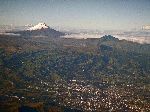 |
Quito is located in a high valley along
the Pan-American highway (Ave of the Volcanoes), among several active
volcanoes. Volcano Cotopaxi is seen in the photo on the right. It's worth at least a couple days of exploration. One of its assets is its natural history and dramatic setting. From various vantage points, to the west is the Volcano Pinchincha, to the south is Volcano Cotopaxi, to the east is Volcano Cayambe and to the north is Volcano Cotacachi. Periodically some of these still come to life. From Parc Metropolitano there are not only great views, but also excellent bike trails and walking routes. |
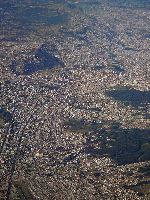 |
|
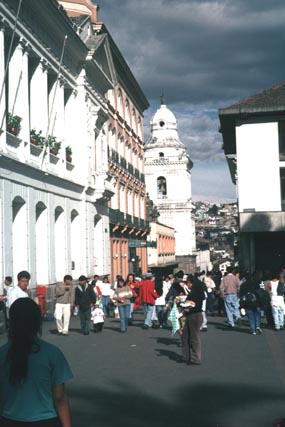
|
First impressions of Quito, the capitol of Ecuador, are that it is a
clean, relaxed, comfortably prosperous
city:
Contradicting this image, the favorite local topic of conversation seems to be how bad the economy is. It may have slow growth, but there are few hallmarks of being really bad. A couple indicators of not everything being rosy for everyone:
|
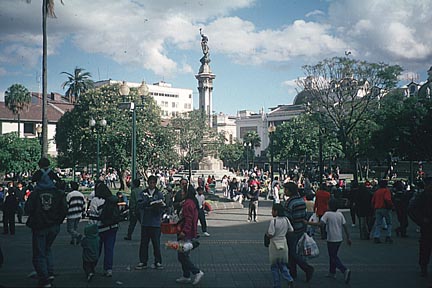
|
|
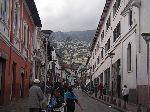 |
Walking or cycling into the neighborhood and reading the signs over the shops and looking at the street life is full of contrasts and curiosities. Because of the geography of the city, in Quito, there is very basic housing with million dollar views. Even without expending much energy the streets of Quito can keep you amused. One of the prime menu items is Quito is a wide variety of succulent fresh squeezed fruit juice drinks. Find the right restaurant with outdoor tables, order a fresh fruit juice and watch the parade of interesting faces that pass. |
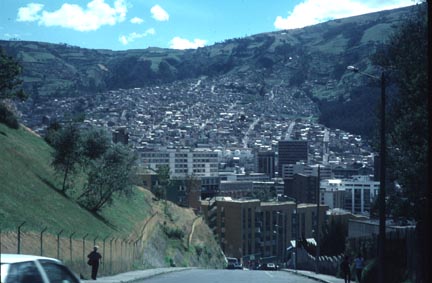 |
|
 |
Here we have a couple of extremes of Quito land use. On the left is a very human scale, walking friendly street in the Mariscal district, with multiple roof lines, a human-friendly street wall, texture, color building and plantings (La Casa Sol Hotel). About ten blocks away, on a right is a wide boulevard with narrow sidewalks, are a KFC and McDonald's facing each other across the intersection. In the central Quito and most small towns the merchandising is still done by small retailers, but on the urban edge there is an increasing number of larger "box" stores and franchise restaurants. |
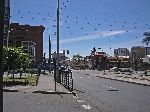 |
|
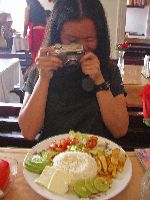 |
Food is very important to bicyclist. So
important that they often photograph it for memories.
P.S. On several consecutive days the comment was made that this is the best meal yet. It is always a question whether the food is getting better or the cyclists are getting hungrier by meal time. Even if the later is true, we ate a lot of superb meals in Ecuador. |
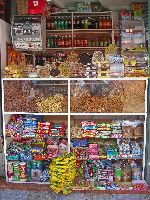 |
|
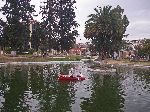 A couple rowing in the lagoon in Parque Alameda, Ouito.
|
The cultural and human history can rival the natural beauty. The history of the area as a trading center goes back a thousand of years. In the intervening centuries it has been completely destroyed by volcanoes or invasions a couple times, but always rebuilt in the same area. On a walking tour of the old town it seems like it takes a half hour to tell the story of every block, building and plaza -- twice as long for every church, of which there are countless. There are a lot of stories about historic churches and dead people, but the district is still alive today. Though the churches can be easier to photograph and document -- as is presented below -- than the vitality of the city, it is not all about churches. There is excellent people watching to be found. The old city is packed with Ecuadorians and in many of the plazas there is entertainment by local performers. The palate is made more interesting and has more texture and color because a lot of people still wear traditional cloths; women in skirts and blouses and men in loose pants and ponchos. |
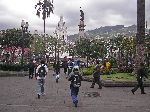
|
|
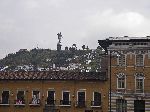 |
At the south end of the Quito is the unique, winged, dancing "Virgin of Quito" monument, on Panecillo ("the little bread loaf") hill. The sculpture is made with 7000 pieces of aluminum. |
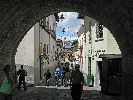 |
|
 |
La Ronda street is known for its preserved colonial architecture and cultural heritage: signs along the street report its artistic and bohemian tradition but otherwise it seems like a quiet backwater now. |
 |
|
 |
Left: Convent San Diego, the Franciscans (?)
constructed this church to provide the priests and laymen with a place of
retreat. Right: San Marco Church, Junin St., another traditionally preserved section of Quito with a number of museums and galleries. |
 |
|
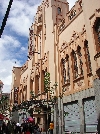 |
Left: the grand Bolivar Theater. It was built
in 1933, but later heavily damaged by fire. There are plans to restore it.
Just down the block is a museum dedicated to Manuela Saenz (born in Quito,
1797). Mostly forgotten by history there are a couple references to her in
Ecuador. She was the illegitimate daughter of a Spanish nobleman, at age 20 she
married an English aristocrat, then became a South American liberationist, spy,
Simon Bolivar partner for eight years (whom life she saved from an
assassination attempt), and an acquaintance of Herman Melville. She died destitute in 1856
in Peru. Right: Italianate Vinci building in old city. |
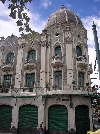 |
|
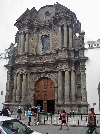 |
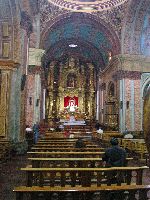 El
Sagrario Church, located just off the Grand Plaza, was originally the main
chapel of the Cathedral, built for the cult of the Holy Sacrament. The alter
(right), with its ornamented Salomon (twisted) columns is an excellent frame for
a high Baroque that leaves practically no space without ornamentation. This
style is typical of Bernardo de Legarda’s sculpture. El
Sagrario Church, located just off the Grand Plaza, was originally the main
chapel of the Cathedral, built for the cult of the Holy Sacrament. The alter
(right), with its ornamented Salomon (twisted) columns is an excellent frame for
a high Baroque that leaves practically no space without ornamentation. This
style is typical of Bernardo de Legarda’s sculpture. |
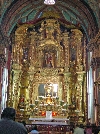 |
|
 |
La Compania de Jesus Church, built by the Jesuits,
is one of the richest churches in America. The extraordinary facade can be
described as a lacework on stone. Six Salomon columns in the lower part support
a second level of different heights. No pictures are allowed in the
heavily gold gilded church. On the top right is a photo of La Compania from San Francisco Church. One one visit to the plaza they were celebrating the potato with the world's biggest cauldron of Loco de Queso (pototo and cheese soup). The plaza was filled with people enjoying live traditional entertainment and sipping bowls of soup. |
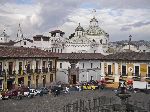 |
|
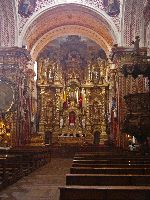 |
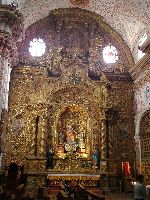 The Church of La Merced
has extraordinary collection of religious art of Quito. Woodcarvings by Bernardo Legarda. The Church of La Merced
has extraordinary collection of religious art of Quito. Woodcarvings by Bernardo Legarda.Far Left: Senor of Devine Love, Church of La Merced. |
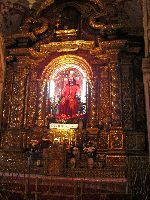 |
|
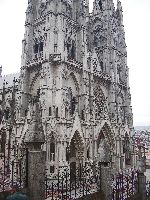 |
Right: Fanciful art on the balconies of the Casa del Artista. Far right: A colorful stairway leads up into the neighborhood. |
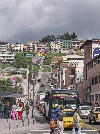 |
|
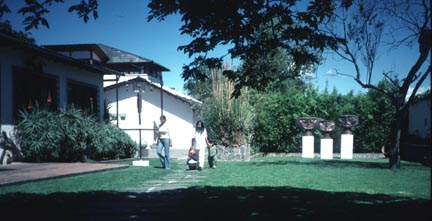 There are a number of
other good museums and galleries in town. One
with a particular Ecuadorian flavor is the Guayasamin. Besides
having an excellent collection of his paintings and sculptures, it has
pre-Colombian pieces and art from the Spanish Catholic colonial
period. There are a number of
other good museums and galleries in town. One
with a particular Ecuadorian flavor is the Guayasamin. Besides
having an excellent collection of his paintings and sculptures, it has
pre-Colombian pieces and art from the Spanish Catholic colonial
period. |
|||
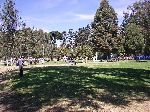
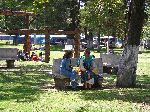 |
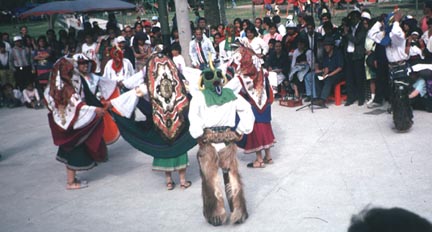 On weekends there is original art for sale and live
music in Parque El Ejido. On weekends there is original art for sale and live
music in Parque El Ejido.
Socializing, relaxing, eating ice cream, Ecuadorian
3 on 3 |
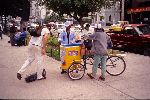 |
|
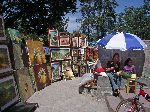 |
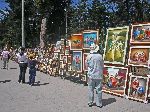
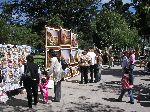 |
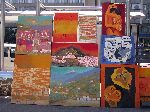 |
|
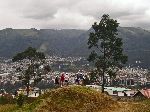 |
One
of the nicest assets of Quito is hilltop Parque Metropalitano. Its forest is
intended to be the lungs (or air filter) of the city, but evidently this aspect is
under threat from development in the park and overwhelmed by development in the
valley. Even
so it offers great views, a variety of recreatiojn trails for bicycling and jogging, kids
play areas and a general opportunity to escape the city and relax.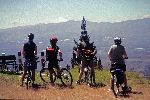  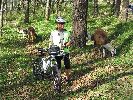 |
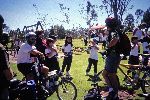 |
|
|
|
|||
|
|
|
||
|
|
|||
|
"Hosted by
DreamHost - earth friendly web hosting"
|
|||
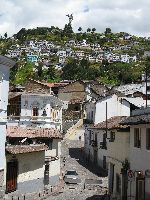
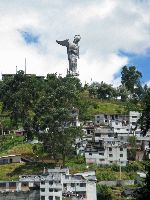
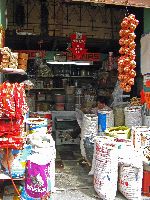
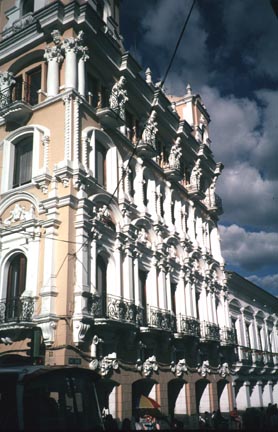
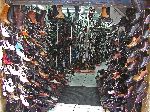
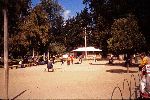
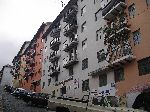
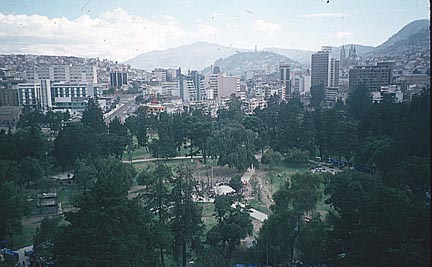

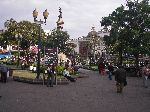
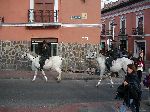
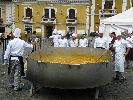
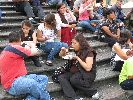

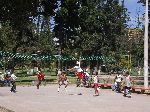
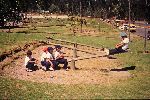
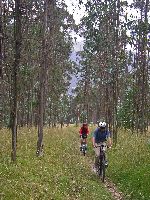




 Please
contact us
Please
contact us